Special Report
The 9 World Leaders Who Have the Power to End Life as We Know It
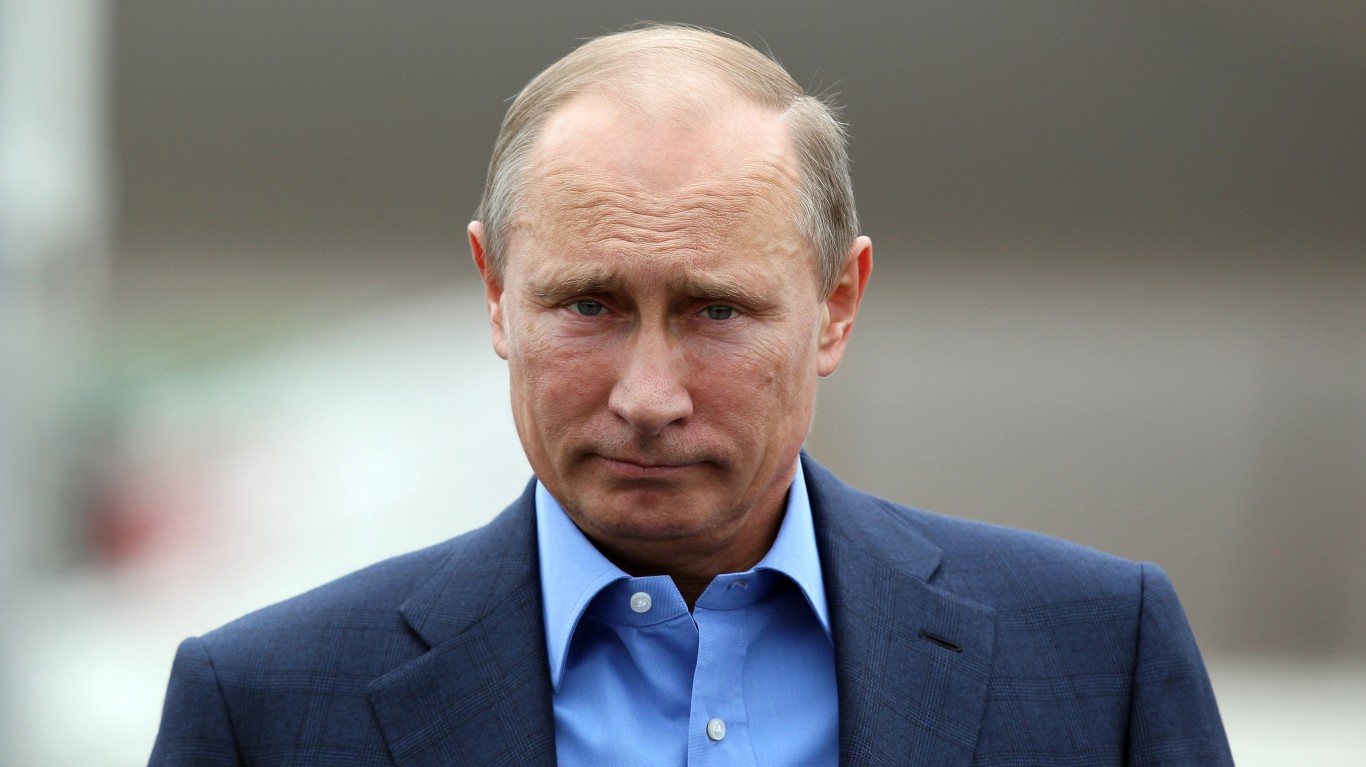
Published:

In Ukraine, defending forces began their counterattack into Russian-controlled territory last month. How far Russia will go in response is unclear. Russian President Vladimir Putin has been quoted as saying that a nuclear strike is not off the table. He has threatened to use “weapons with a nuclear component” and there are some who fear he might even consider using one or more of Russia’s world-leading 5,977 nuclear bombs on Ukraine or one of its NATO member neighbors. (These are the nine countries with nuclear weapons, ranked.)
Vladimir Putin is one of nine global leaders with a nuclear arsenal, capable of destroying life on earth as we know it. Using data from the 2022 Status of World Nuclear Forces, a report by the nonprofit global policy think tank Federation of American Scientists, 24/7 Wall St. identified the nine people who lead the world’s nuclear-armed states.
Nuclear weapons are considered – both by countries pursuing them and those possessing them – as a deterrent to would-be aggressors. The Cold War between the Soviet Union and the United States would not likely have remained cold had it not been for mutual assured destruction – a defense principle warning that a nuclear strike by one power would be met with a devastating counterattack by the other and result in the annihilation of both belligerents. (This is what a nuclear attack would do to the America’s 25 largest cities.)
A nuclear explosion can drive ground temperatures up to over 7,000 degrees Fahrenheit and create destructive shockwaves, potentially killing millions in densely-populated cities. But the devastation can also extend far beyond the immediate blast radius. Multiple nuclear explosions, should any one of the countries on this list engage in a nuclear war, could send millions of tons of black smoke into the stratosphere, reducing sunlight and lowering global temperatures, resulting in lower crop yields and mass famine, to name but a few of the consequences. (This is what a nuclear winter would do to the Earth.)
The nuclear arsenals of today are far more advanced – and destructive – than those of the previous century. Nuclear weapons can now be deployed from the sea, land, and air, and they range greatly in power. Russia, for example, is known to have tactical nuclear weapons, which are generally smaller and designed to be used on the battlefield. Russia has also successfully tested a hydrogen bomb with a 50 megaton payload – a force over 1,500 larger than the bombs used in Hiroshima and Nagasaki and equal to more than 10 times all the munitions used throughout World War II.
Click here to see the nine leaders who have the power to destroy life on Earth.
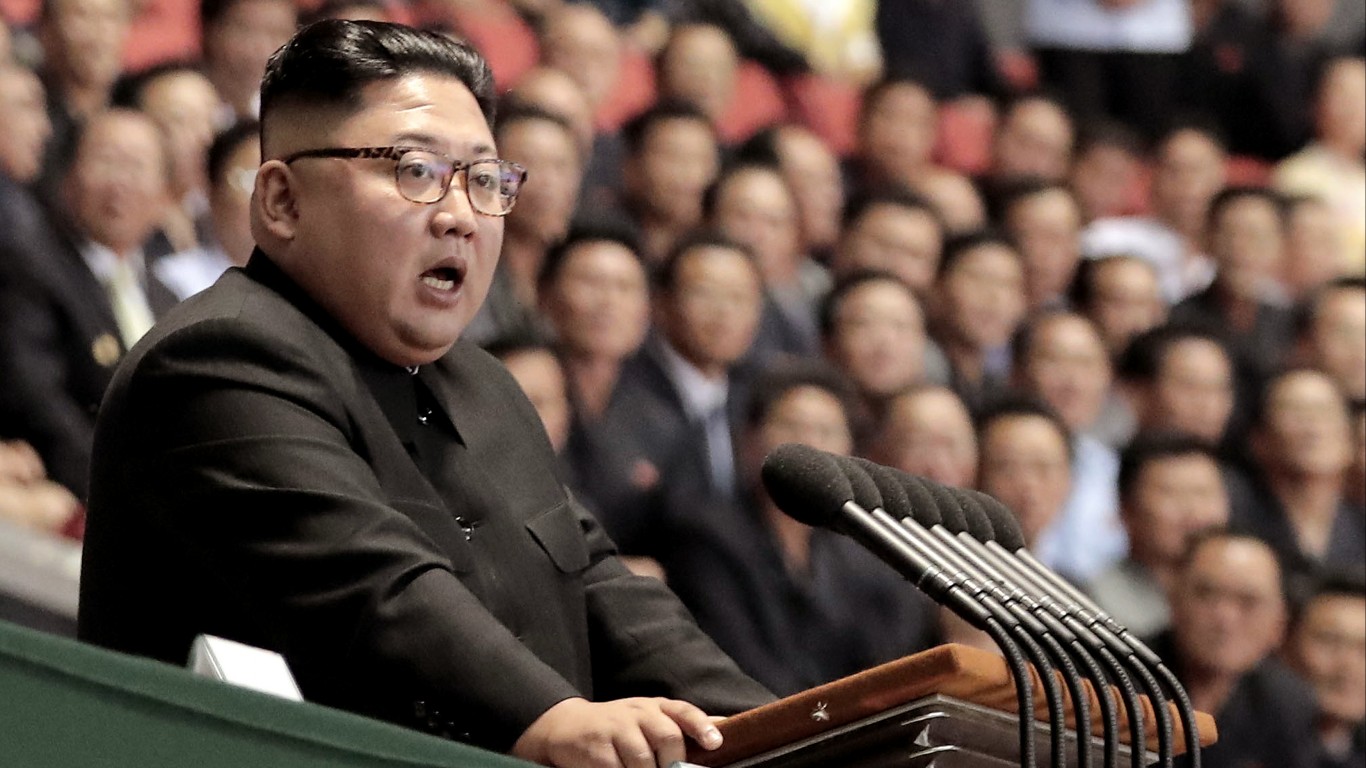
1. Supreme Leader Kim Jong-un
> Leader of: North Korea
> Took office: Dec. 28, 2011
> Estimated nuclear arsenal: 20
> First nuclear weapons test: 2006
Kim Jong-un is North Korea’s third head of state, following in the footsteps of his late father and grandfather, Kim Jong-il and Kim Il-sung. Since becoming North Korea’s supreme leader in December 2011 at age 27, Kim Jong-un has made North Korea a global threat more than his father ever did. The 38-year-old has embraced the “military first” doctrine, emphasizing development of the country’s nuclear and missile programme. Kim is one of only a few heads of state with the power to start a nuclear war.
Founded after a failed attempt to unite the Korean Peninsula by force in the mid-20th century, the North Korean regime has been built around the absolute power of its leaders and has a history marked by famine, censorship, and isolation from the global community. As a pariah state, the country’s nuclear weapons are central to its perception of itself as a powerful geopolitical force.
Recent provocations coming from Pyongyang have much of East Asia on high alert. So far this year, North Korea has tested 86 missiles – a record number – one of them crashing 35 miles off South Korea’s coast. These tests included intermediate range and intercontinental ballistic missiles fired towards or directly over Japan.
[in-text-ad]

2. Prime Minister Yair Lapid / Benjamin Netanyahu
> Leader of: Israel
> Took office: Lapid took office July 1, 2022. Netanyahu was mandated to form a new government Nov. 13, 2022
> Estimated nuclear arsenal: 90
> First nuclear weapons test: Unknown, possibly 1979
Israel is the world’s only Jewish state, and its location among a number of hostile Islamic states in the Middle East all but necessitates a strong and constant defensive posture. Though Israel has never confirmed nor denied possession of nuclear weapons, it is universally acknowledged to be among the world’s nine nuclear powers, with an estimated 90 nuclear warheads.
Yair Lapid became prime minister on July 1, 2022 – just ahead of the November election – and he will remain PM until the new government is formed. After the election, Benjamin Netanyahu was mandated to form the next government. Netanyahu, who already served as prime minister for 15 years before he was unseated a year and half ago, is known for his hawkish views and strong objection to Iran’s nuclear weapons program. Israel’s status as a nuclear power is a point of contention for its regional adversaries, and is often cited as justification for Iran’s nuclear weapons development program.
While Israel has its own robust domestic weapons program, it also imports weapons from Europe and the United States. From 1999 to 2018, the U.S. committed approximately $50 billion in military aid to Israel, and pledged nearly $40 billion over the period from 2019 to 2028.
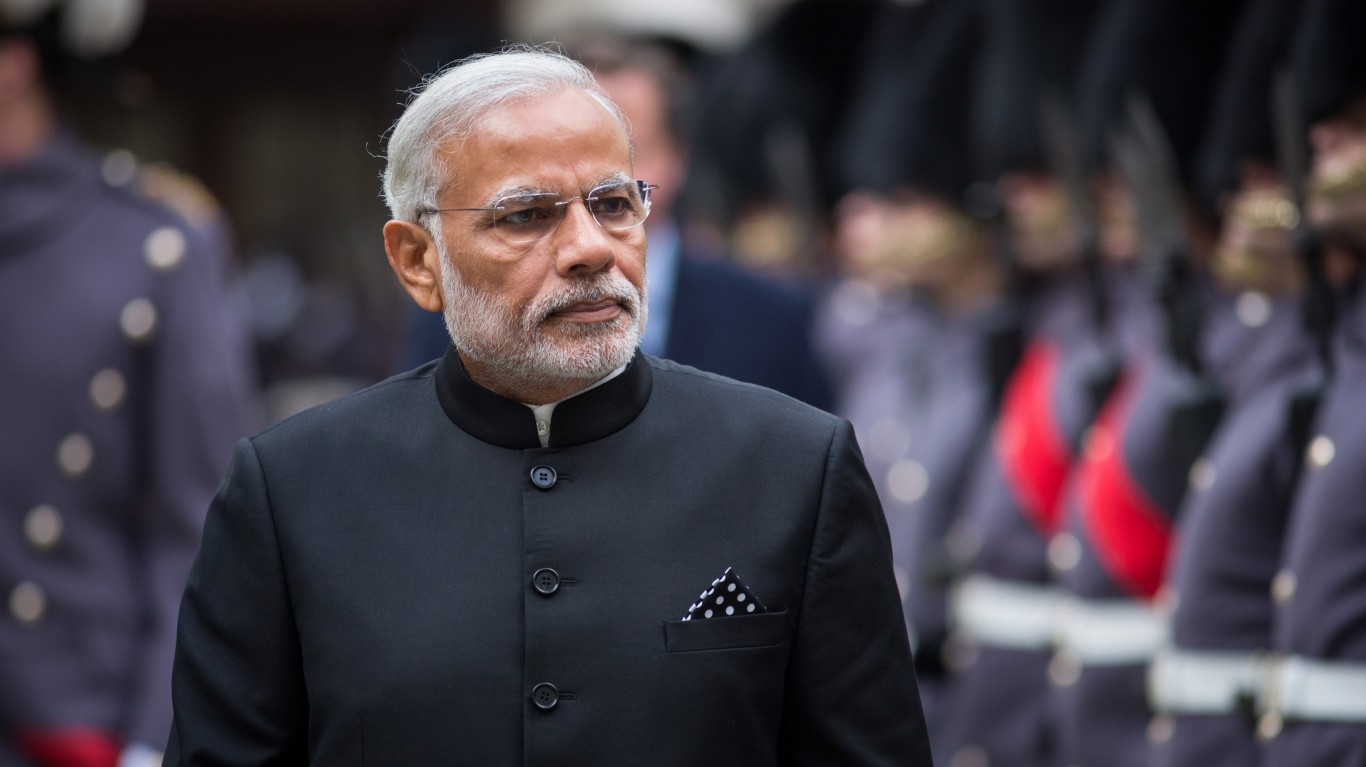
3. Prime Minister Narendra Modi
> Leader of: India
> Took office: May 26, 2014
> Estimated nuclear arsenal: 160
> First nuclear weapons test: 1974
Indian Prime Minister Narendra Modi controls an estimated 160 nuclear warheads, making him one of the most powerful men in world history. India conducted its first nuclear weapons test in 1974 and recently announced upgrades to its missile delivery system.
A British colony until 1947, the colony was split into India and Pakistan upon gaining independence – and an ongoing dispute over the Kashmir region with Pakistan makes the border one of the most dangerous in the world. The 2,167-mile border between India and China along the Himalayas has also been in dispute for over 80 years and is perhaps the more concerning of the two considering both countries’ regional and global significance.
Modi, who won back-to-back elections and is known for his nationalist stance, ordered a retaliation in 2019 in the Jammu and Kashmir region and in 2020 instructed the Indian army to stand its ground amid a deadly border skirmish with China. Since assuming office, Modi has embraced relations with the United States and regional with middle-sized powers in an effort to balance China’s rising influence, according to Foregin Policy.
All three adversaries have nuclear weapons at their disposal, elevating the risk of catastrophe in the event the border dispute escalates into a full-fledged war.
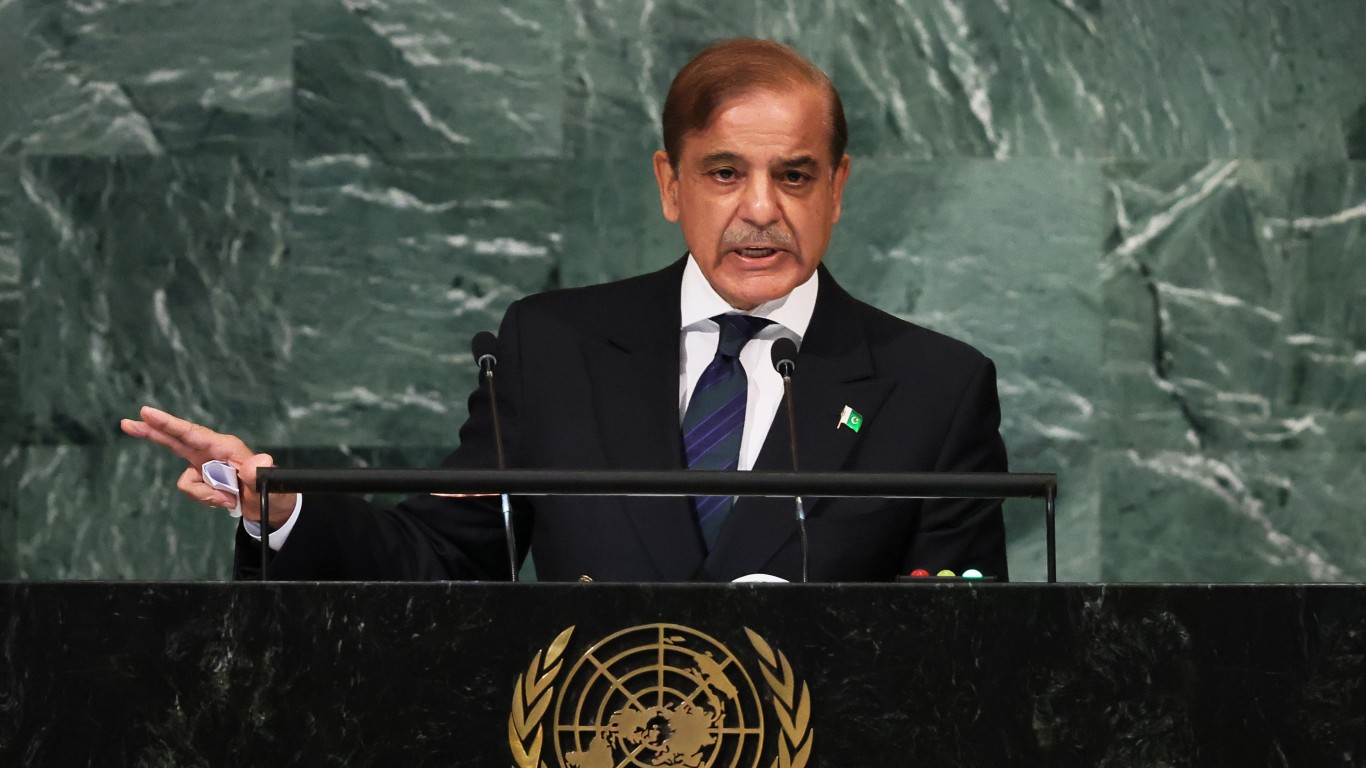
4. Prime Minister Shehbaz Sharif
> Leader of: Pakistan
> Took office: April 11, 2022
> Estimated nuclear arsenal: 165
> First nuclear weapons test: 1998
Pakistan’s nuclear weapons development program began in 1974 following a successful nuclear test conducted by its neighbor and geopolitical rival, India. Pakistan first demonstrated its new nuclear capabilities in 1998 and is now among the nine nations with nuclear weapons.
Today, Pakistan is estimated to have 165 nuclear warheads, a deep concern for world leaders – not only because of the potential for conflict with India, but also the threat of terrorism. Since the Taliban took control of Afghanistan, which shares a 1,640 mile border with Pakistan, fears that a similarly-aligned group could take over of Pakistan’s government and that nuclear weapons could fall into terrorist hands have grown considerably.
Trust between the U.S. and Pakistani governments is shaky. Pakistan is already known to have helped North Korea and Iran with their nuclear weapons programs, and the U.S. has reportedly developed a plan to seize Pakistan’s nuclear stockpiles should terrorist groups ever come close to capturing them. Pakistan’s Prime Minister Shehbaz Sharif has been in power for less than a year. Among the many challenges he faces are a flailing economy and rising terrorism. As far as foreign policy is concerned, the man controlling Pakistan’s nuclear arsenal is importantly expected to maintain amicable relations with India. He might attempt to repair relations with the U.S. but also continue to foster relations with China.
[in-text-ad-2]
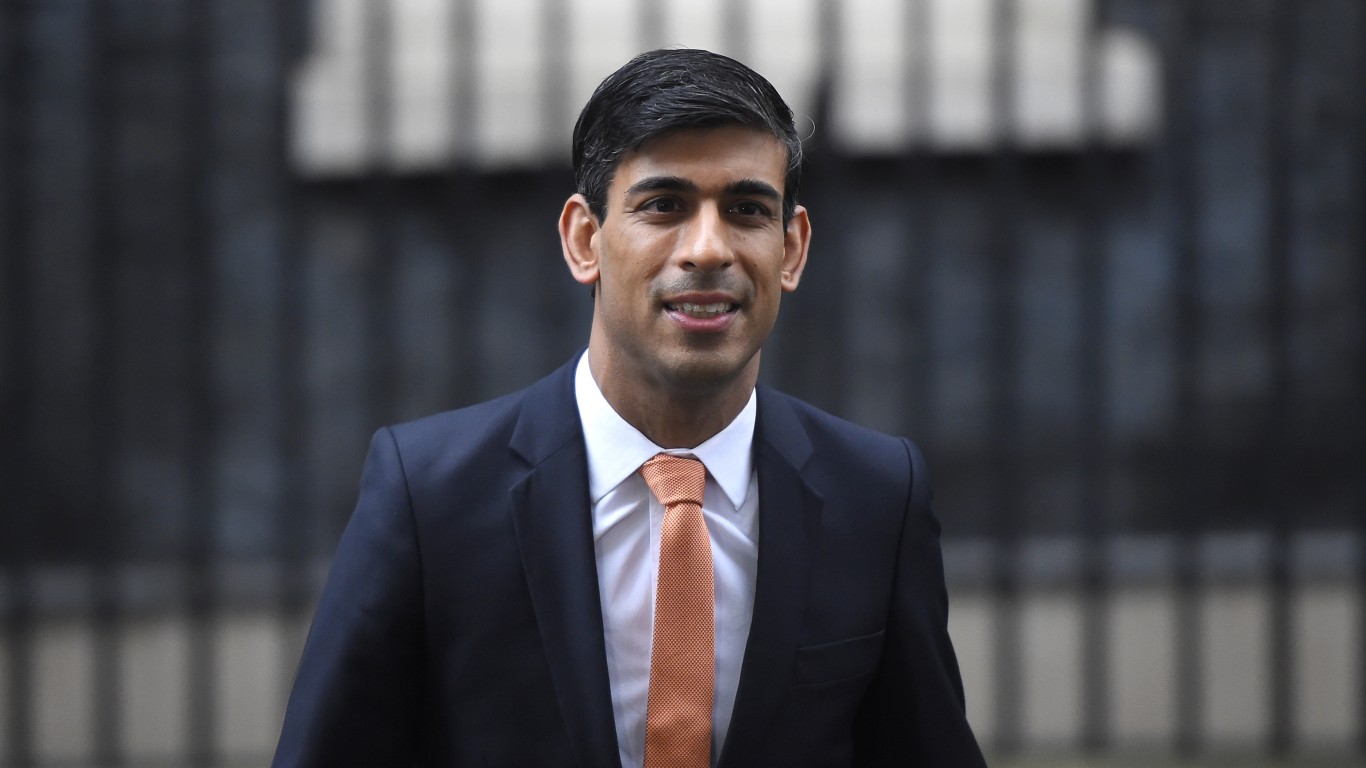
5. Prime Minister Rishi Sunak
> Leader of: United Kingdom
> Took office: Oct. 25, 2022
> Estimated nuclear arsenal: 225
> First nuclear weapons test: 1952
Great Britain began developing a nuclear bomb during World War II and conducted its first successful test in October 1952. Seventy years later, on Oct. 25, 2022, Rishi Sunak went from being a British MP and Chancellor of the Exchequer to the Prime Minister, controlling one of the world’s largest nuclear arsenals.
In addition to ongoing crises at home, international threats would also test the new PM. Russian state TV broadcast in May simulations of Ireland and Britain wiped out by nuclear bombs. While former PM Lizz Truss promised to increase defense spending as a response to Russian aggression in Ukraine, Sunak has not met the pledge.
The U.K. has been in a decades-long Mutual Defence Agreement with the United States, which allows the two allied nations to exchange nuclear materials, technology, and information to mutually benefit from technological advancements. The agreement has been renewed nine times and will be up for renewal once again at the end of 2024.
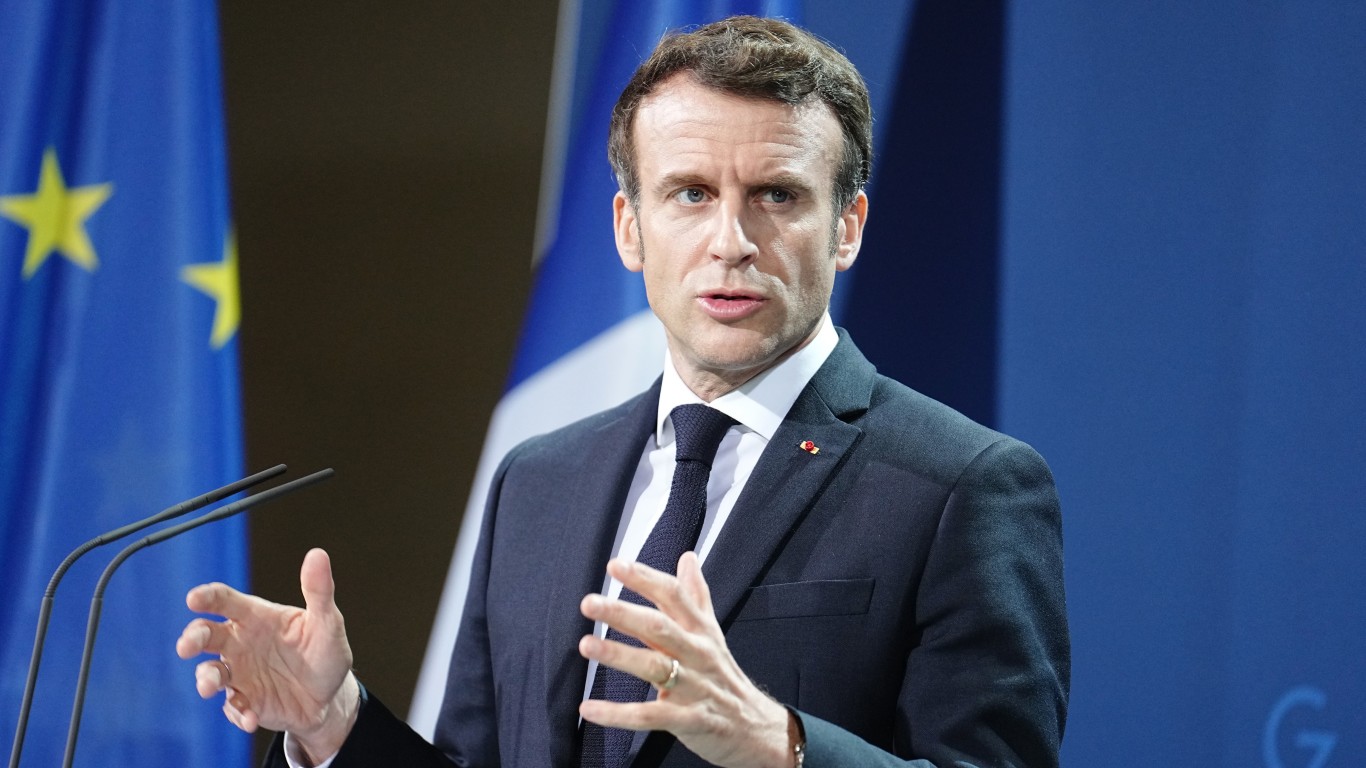
6. President Emmanuel Macron
> Leader of: France
> Took office: June 8, 2017
> Estimated nuclear arsenal: 290
> First nuclear weapons test: 1960
France is the only nuclear armed country in western continental Europe. One of the world’s older nuclear powers, France conducted its first successful nuclear weapons test in 1960. The country’s 290 nuclear weapons are deployable both by submarine and air-launched cruise missiles.
France’s nuclear program began in World War II but was put on hold during the German occupation. The program resumed upon liberation, and French atomic weapons were operational and ready for military use by 1964.
The nuclear arsenal in France is now under the control of President Emmanuel Macron, who has been in office since June 2017. He recently came under fire when he said France would not use nuclear weapons in response to a Russian nuclear attack on Ukraine.
[in-text-ad]

7. President Xi Jinping
> Leader of: China
> Took office: Nov. 15, 2012
> Estimated nuclear arsenal: 350
> First nuclear weapons test: 1964
The Chinese nuclear weapons program began in the 1950s in collaboration with the Soviet Union – with the Chinese supplying uranium ore to the Soviets in exchange for assistance in nuclear technology. Though the Soviets eventually backed out of the deal, China conducted its first successful nuclear test in 1964.
China has been ruled by President Xi Jinping since 2012. In recent years, Xi has installed loyalists in high positions and done away with measures that constrain his power. With his authoritarian regime governing over 1.4 billion people, and a nuclear arsenal of an estimated 350 warheads, Xi may now be the single most powerful person in the world.
Since 2018, China has taken considerable steps to expand its nuclear capabilities and build out its arsenal. Like the U.S., China now has a nuclear triad – warheads that can be deployed from submarines, aircraft, and land with road mobile ICBMs. Unlike the Russian nuclear threat, which is countered by NATO allies, the U.S. has no comparable treaty in the Indo-Pacific region to counter the rising Chinese threat.

8. President Joseph Biden
> Leader of: United States
> Took office: Jan. 20, 2021
> Estimated nuclear arsenal: 5,428
> First nuclear weapons test: 1945
The U.S. became the first country to develop nuclear weapons in 1945, and to this day remains the only country in history to use nuclear weapons in war, after dropping one on the Japanese city of Hiroshima on August 6, 1945, and another on Nagasaki three days later.
In the post war era, distrust and resentment between the U.S. and Soviet Union devolved into a decades-long Cold War – and the most significant arms race in world history. Nuclear escalation between the two superpowers resulted in the U.S. stockpiling over 31,000 nuclear weapons and the Soviets arming themselves with over 40,000. The two countries came close to plunging the world into nuclear war several times in the Cold War years from 1947 to 199, most notably during the Cuban Missile Crisis of 1962.
In the post Cold War era, the U.S. has dismantled the bulk of its nuclear weapons but still has nearly 5,500 warheads in its arsenal, which can be deployed by air, sea, and land-based missiles.
Codes to launch the nuclear weapons in the U.S. inventory are at the control of President Joe Biden, and like previous presidents, Biden has conducted a Nuclear Posture Review, avoiding significant changes. While the NPR does not rule out first use of nuclear weapons, it does state that “the United States would only consider the use of nuclear weapons in extreme circumstances.” Biden faced criticism over NPR for not reducing the arsenal or taking a different approach, while U.S. allies have welcomed the status quo in the stance.

9. President Vladimir Putin
> Leader of: Russia
> Took office: May 7, 2012 (also from 1999-2008)
> Estimated nuclear arsenal: 5,977
> First nuclear weapons test: 1949
Russia has more nuclear weapons than any other nation on Earth. There are an estimated 5,977 nuclear warheads under Russian control, or about 47% of the total 12,700 estimated nuclear weapon count globally. The Soviet Union carried out its first successful nuclear weapons test in 1949, at the outset of the Cold War, and proceeded to build an arsenal that peaked at over 40,000 warheads in 1986.
Tensions between the U.S. and Russia are now at a post Cold War high, following the country’s unprovoked invasion of Ukraine in February 2022. As the conflict in Ukraine continues to rage, concerns over Russia’s potential deployment of tactical nuclear weapons on the battlefield are mounting.
President Vladimir Putin has repeatedly made direct and veiled threats about the use of nuclear weapons since the war started. Recent military setbacks in Ukraine have further caused U.S. and NATO officials to speculate that, if backed into a corner, the Kremlin may choose to use nuclear weapons. Even before the Ukrainian offensive began, relations between the U.S. and Putin, an ex-KGB agent, were deteriorating.
Credit card companies are handing out rewards and benefits to win the best customers. A good cash back card can be worth thousands of dollars a year in free money, not to mention other perks like travel, insurance, and access to fancy lounges. See our top picks for the best credit cards today. You won’t want to miss some of these offers.
Flywheel Publishing has partnered with CardRatings for our coverage of credit card products. Flywheel Publishing and CardRatings may receive a commission from card issuers.
Thank you for reading! Have some feedback for us?
Contact the 24/7 Wall St. editorial team.